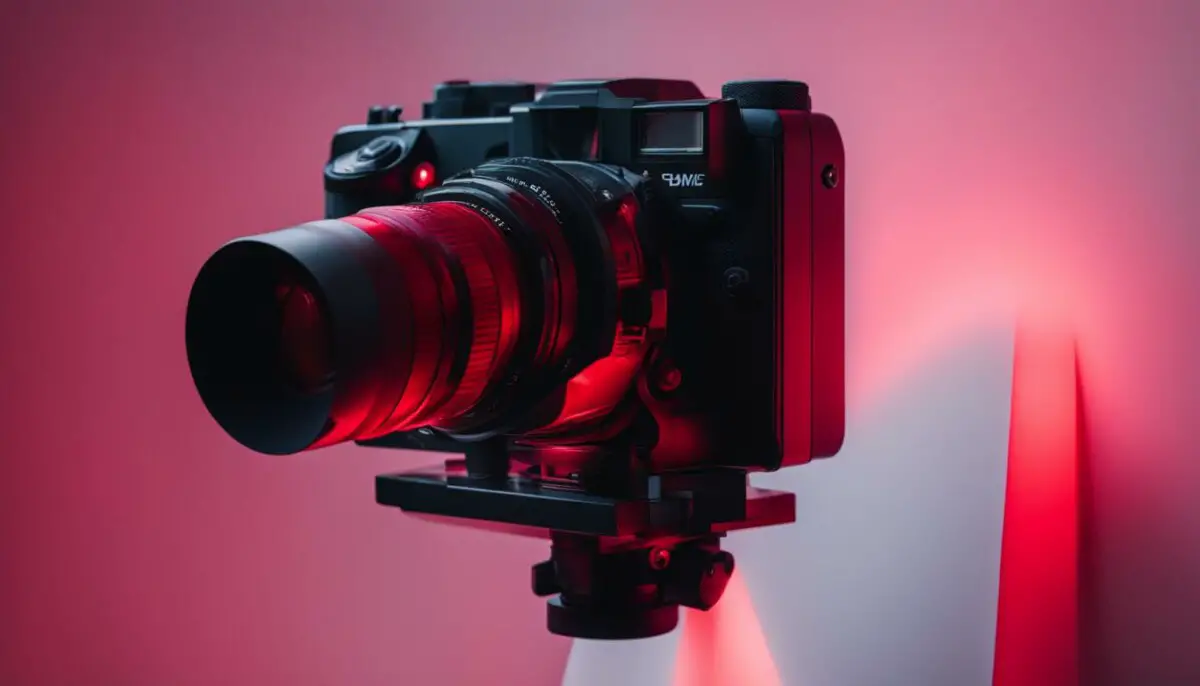Last Updated on 6 months by Francis
In today’s surveillance-heavy world, the question of whether infrared lights can block cameras is a common one. Fortunately, we have gathered information from various sources to provide a clear answer. Let’s dive into the details and explore the possibilities.
Contents
Key Takeaways:
- Infrared lights have the potential to interfere with the functioning of surveillance cameras.
- By emitting 940nm infrared (IR) wavelengths, these lights can overload the photo diodes in IR-sensitive cameras.
- This overload can disrupt the camera’s ability to capture clear images, effectively blocking its visibility or making the captured footage less recognizable.
- DIY solutions, such as the Freedom Shield and Camera Shy Hoodie, have been developed to block cameras using infrared lights.
- Measures can be taken to prevent or mitigate infrared light interference, such as using protective camera housings and anti-laser films.
Understanding the Concept of Blocking Cameras with Infrared Lights
In today’s increasingly surveillance-heavy world, it is important to understand the potential impact of infrared lights on camera detection and interference. By emitting invisible 940nm infrared (IR) wavelengths, these lights have the ability to disrupt the functioning of infrared-sensitive cameras.
When infrared lights overpower the photo diodes in IR-sensitive cameras, it can lead to an overload that hampers the camera’s ability to capture clear images. As a result, the camera’s visibility may be blocked or the recorded footage may appear distorted or less recognizable.
It is important to note that not all cameras are equally affected by infrared lights. Some cameras are equipped with filters or protective features that minimize the interference caused by these lights. However, many standard surveillance cameras are susceptible to the disruption caused by infrared lights.
When infrared lights overpower the photo diodes in IR-sensitive cameras, it can lead to an overload that hampers the camera’s ability to capture clear images.
To further explore this topic, let’s take a closer look at some examples of DIY solutions for camera blocking using infrared lights.
Examples of DIY Solutions for Camera Blocking
Innovative individuals have developed creative solutions to mitigate camera detection using infrared lights. One such solution is the Freedom Shield, created by engineer Nick Bild. The Freedom Shield incorporates 940nm IR LEDs into clothing, effectively hiding individuals from surveillance cameras by overwhelming their ability to capture clear images.
Another example is the Camera Shy Hoodie, developed by Mac Pierce. This garment features high-powered infrared LEDs sewn into the fabric, designed to blind night vision cameras and prevent them from capturing recognizable footage.
These DIY solutions demonstrate the potential for using infrared lights to block or interfere with camera detection, highlighting the need for enhanced security measures in our increasingly surveillance-oriented society.
| DIY Solutions | Features |
|---|---|
| Freedom Shield | Utilizes 940nm IR LEDs embedded in clothing |
| Camera Shy Hoodie | Features high-powered infrared LEDs sewn into the fabric |
Examples of DIY Solutions for Camera Blocking
Innovative individuals have come up with DIY solutions for blocking cameras using infrared lights. These creative approaches offer an alternative for privacy-conscious individuals who want to protect themselves from surveillance. Let’s explore some interesting examples:
Freedom Shield
The Freedom Shield, created by engineer Nick Bild, is a unique solution that utilizes 940nm IR LEDs embedded in clothing to hide individuals from surveillance cameras. The concept behind this DIY project is to create a protective shield that can prevent cameras from capturing clear images. By strategically placing infrared lights on clothing, the Freedom Shield aims to overwhelm the photo diodes in IR-sensitive cameras, effectively blocking their visibility or making the captured footage less recognizable.
Camera Shy Hoodie
Another innovative creation is the Camera Shy Hoodie, developed by Mac Pierce. This hoodie features high-powered infrared LEDs sewn into the garment, which can blind night vision cameras. The infrared lights emit a powerful beam that interferes with the camera’s ability to capture clear images, rendering it ineffective for surveillance purposes. The Camera Shy Hoodie is an interesting example of how DIY enthusiasts can leverage infrared lights to protect their privacy.
These DIY solutions showcase the ingenuity of individuals who are concerned about their privacy in today’s surveillance-oriented world. By employing infrared lights strategically, these innovative projects offer an affordable and accessible way to block or interfere with surveillance cameras.
| DIY Solution | Description |
|---|---|
| Freedom Shield | A clothing accessory embedded with 940nm IR LEDs to block surveillance cameras. |
| Camera Shy Hoodie | A hoodie with high-powered infrared LEDs sewn into the fabric to blind night vision cameras. |
Preventing Infrared Light Interference with Security Cameras
When it comes to security camera systems, one common challenge is the potential interference caused by infrared lights. Understanding the impact of infrared light on camera visibility and implementing preventive measures is crucial for ensuring reliable surveillance. By taking certain precautions, you can minimize the disruption caused by infrared light and maintain the effectiveness of your security system.
Choosing the Right Camera
One effective approach to prevent infrared light interference is to select cameras specifically designed to handle such situations. Look for cameras with built-in infrared blocking filters. These filters help to minimize the effect of infrared light on the camera sensor, resulting in clearer and more accurate images. Additionally, consider cameras with adjustable infrared settings that allow you to fine-tune the sensitivity to your specific needs. This flexibility can help you strike the right balance between visibility and minimizing potential interference.
Optimizing Lighting Conditions
Another way to mitigate the impact of infrared light is to optimize the lighting conditions in your surveillance area. This involves assessing the ambient lighting and making adjustments as needed. By ensuring a balanced distribution of lighting, you can reduce the reliance on infrared illumination, minimizing the chances of interference. Experimenting with different lighting sources and angles can help you find the optimal setup that minimizes the effects of infrared light on camera visibility.
Physical Barriers and Positioning
Physical barriers can also play a role in blocking or redirecting infrared light. Utilizing walls, fences, or screens strategically can help create obstacles that prevent the undesired penetration of infrared light into the camera’s field of view. However, it is important to consider the positioning of these barriers to ensure that they do not obstruct the camera’s line of sight or compromise the overall surveillance coverage. Careful planning and adjustment of physical barriers can significantly reduce the impact of infrared light interference.
By implementing these preventive measures, you can enhance the performance and reliability of your security camera system. Understanding the impact of infrared light on camera visibility and taking proactive steps to mitigate its effects is crucial for maintaining a robust surveillance solution.
| Preventive Measures | Benefits |
|---|---|
| Choosing cameras with built-in infrared blocking filters | Minimizes interference and ensures clear images |
| Optimizing lighting conditions | Reduces reliance on infrared illumination and mitigates interference |
| Using physical barriers strategically | Blocks or redirects infrared light to prevent interference |
Protective Measures for Security Cameras
When it comes to protecting security cameras from infrared lasers, there are several effective measures that can be implemented. These measures not only enhance the security of the cameras but also help ensure the integrity of the footage they capture. By taking these precautions, you can minimize the risks associated with infrared light interference and maintain reliable surveillance.
One important step in camera protection is the installation of camera housings made of sturdy materials. These housings act as a physical barrier, shielding the camera from direct exposure to laser beams. This can significantly reduce the chances of the camera’s functionality being compromised by an infrared laser.
Another useful measure is the application of anti-laser films to the camera lens. These films work by reducing the intensity of the laser beams, further safeguarding the camera against potential interference. By minimizing the impact of infrared lasers, the camera can continue to capture high-quality footage without distortion or loss of clarity.
Features of the Most Powerful Cameras Against Infrared Lasers
When selecting security cameras for areas prone to laser interference, it is essential to choose models that offer advanced protective features. The most powerful cameras against infrared lasers typically include the following key attributes:
- Infrared Blocking Filters: These filters are designed to block or attenuate infrared light, preventing it from affecting the camera’s image sensor. By effectively filtering out unwanted infrared wavelengths, these cameras can maintain accurate color reproduction and minimize the risk of interference.
- Metal Housings: Cameras with metal housings not only provide better physical protection but also help dissipate heat more effectively. This ensures optimal performance even in challenging environments and reduces the chances of damage caused by laser exposure.
- High-Quality Image Sensors: Cameras equipped with high-quality image sensors offer enhanced sensitivity to visible light, making them less prone to interference from infrared lasers. These sensors capture more detailed and accurate images, providing reliable surveillance footage.
By considering these features when selecting security cameras, you can ensure increased protection against infrared laser interference and maintain the effectiveness of your surveillance system.
| Protective Measure | Advantages |
|---|---|
| Camera Housings | Physical barrier against laser beams |
| Anti-Laser Films | Reduces intensity of laser beams |
| Infrared Blocking Filters | Prevents interference with image sensor |
| Metal Housings | Better physical protection and heat dissipation |
| High-Quality Image Sensors | Enhanced sensitivity to visible light |
Implementing these protective measures and choosing cameras with advanced features can significantly enhance the security and reliability of your surveillance system. By taking the necessary precautions, you can minimize the risks associated with infrared laser interference and ensure the continuous protection of your property or premises.
Conclusion
In conclusion, the use of infrared lights can indeed interfere with surveillance cameras. By emitting infrared wavelengths that overwhelm the camera’s sensor, these lights have the potential to disrupt the camera’s functionality and make captured footage less clear. However, there are measures that can be taken to prevent or mitigate this interference.
Protective camera housings made of sturdy materials can shield the camera from direct exposure to infrared lasers, while anti-laser films applied to the camera lens can reduce the intensity of the laser. Physical barriers such as walls, fences, or screens can also prevent infrared beams from reaching the camera. Additionally, implementing a multi-layered security system and using alternative lighting sources can help reduce the impact of infrared light interference.
It’s important to note that while these measures can significantly enhance camera protection, no camera is completely immune to infrared light interference. Therefore, it is crucial to carefully evaluate the specific surveillance needs and consider a combination of protective measures to ensure optimal camera performance.
FAQ
Do infrared lights block cameras?
Yes, infrared lights have the potential to interfere with the functioning of surveillance cameras by overwhelming the camera’s sensor with infrared wavelengths. This can disrupt the camera’s ability to capture clear images.
Can infrared lights affect camera visibility?
Absolutely. By emitting infrared wavelengths that are invisible to the human eye, these lights can block or make the captured footage less recognizable, impacting camera visibility.
How can I block cameras with infrared lights?
Some DIY solutions include utilizing infrared lights embedded in clothing, such as the Freedom Shield, or high-powered infrared LEDs sewn into garments like the Camera Shy Hoodie. These can hide individuals from surveillance cameras and blind night vision cameras respectively.
What measures can be taken to prevent infrared light interference with security cameras?
Dome cameras with shaded or smoked glasses can make it difficult to directly target the camera lens with infrared lasers. Closing the camera’s infrared (IR) mode and using alternative lighting sources can also help reduce the impact of infrared light interference.
How can I protect security cameras from infrared lasers?
Installing camera housings made of sturdy materials can shield the camera from direct exposure to laser beams. Applying anti-laser films to the camera lens can further reduce the laser’s intensity. Physical barriers such as walls, fences, or screens can also prevent laser beams from reaching the camera. Motion detection sensors and implementing a multi-layered security system can enhance camera protection.
What features should I look for in cameras to protect against infrared lasers?
Powerful cameras often feature high-quality image sensors, built-in protective features, infrared blocking filters, and metal housings, which can enhance their resilience against infrared laser interference.









